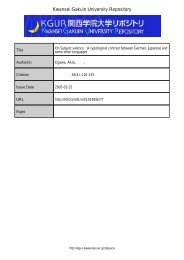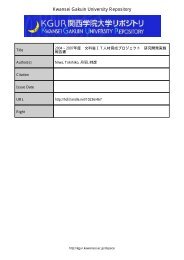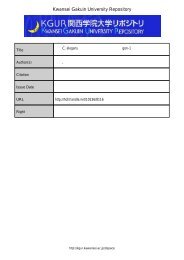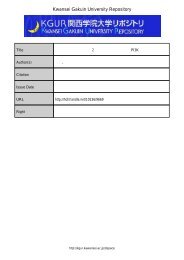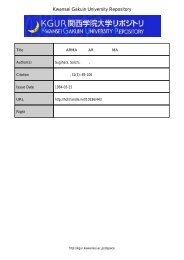Kwansei Gakuin University Repository
Kwansei Gakuin University Repository
Kwansei Gakuin University Repository
Create successful ePaper yourself
Turn your PDF publications into a flip-book with our unique Google optimized e-Paper software.
the number of years after the firm starts a business and the baseline hazard controls<br />
for the risk to all firms of the same age. 13 However, not all the firms in our data<br />
set were necessarily founded in the same year; that is, entry years differ between<br />
firms. As new firms may face different macroeconomic conditions related to the<br />
year of entry, we will control for entry-year cohorts in the model. In the following<br />
subsection, we explain the vector of covariates, xij, in our model.<br />
4. Determinants of exit<br />
As repeatedly explained, we explore heterogeneity in the determinants of exit of<br />
new firms. More specifically, we examine empirically how factors affecting the exit<br />
of new firms vary across bankruptcy, voluntary liquidation, and merger. We discuss<br />
industry-, region-, firm-, and entrepreneur-specific characteristics that affect the exit<br />
of new firms and present independent variables as the determinants of exit.<br />
As for industry-specific characteristics, we first examine the effect of capital<br />
intensity on each form of exit. As is often argued, capital intensity is likely to be<br />
associated with sunk costs (e.g., Cabral, 1995). Large amounts of capital indicate<br />
sufficient capacity and size, and new firms are required to establish and operate<br />
large-sized plants in, for example, processing industries. Because entry and exit<br />
may be limited to some extent in capital-intensive industries, business failure is less<br />
likely to occur in such industries. 14 On the other hand, firms in capital-intensive<br />
industries may have more salable resources, such as physical facilities and real estate,<br />
compared with those in labor-intensive industries. In this respect, it is predicted<br />
that capital intensity has a positive effect on voluntary liquidation and merger. In<br />
this paper, industry’s capital intensity (CAP ) is defined as the ratio of physical fixed<br />
13 In our data set, there are several cases in which entry and exit occurred in the same year. Following<br />
some previous studies (e.g., Thompson, 2005), therefore, the duration of survival is measured<br />
by the firm’s age plus 0.5, in order to avoid simultaneous entry and exit.<br />
14 In addition, capital intensity is closely associated with scale economies, which increase the cost<br />
disadvantage and therefore the exposure to risk confronting a new establishment (Audretsch and<br />
Mahmood, 1995).<br />
13



